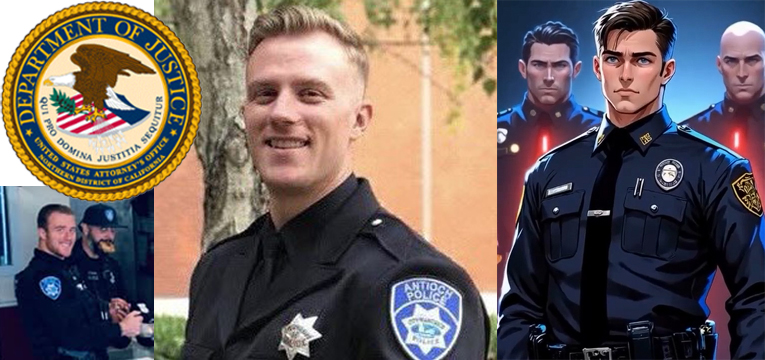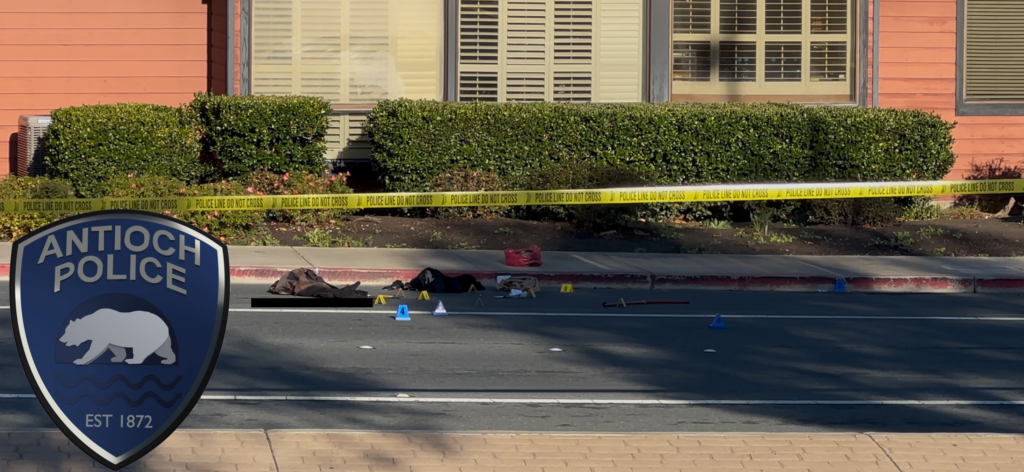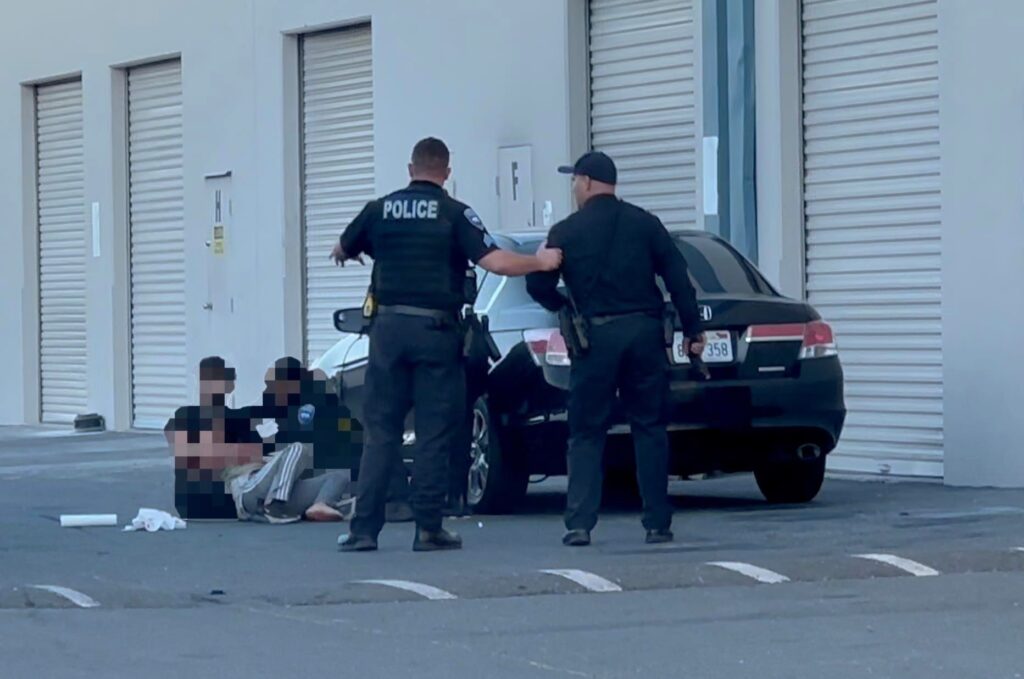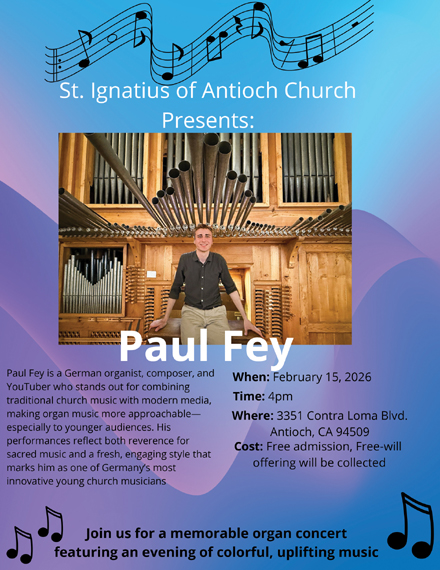Former Antioch cop sentenced to 7.5 years in prison for conspiring to violate civil rights, distribute steroids, and obstructing justice
Tuesday, December 2nd, 2025
Devon Wenger claims he was framed, retaliated against as a whistleblower, suing police department; posts animated video on Instagram, shares two articles to offer his side of the story
By Michele Lo, PIO, U.S. Attorney’s Office Northern District of California
OAKLAND – Former Antioch police officer Devon Christopher Wenger was sentenced today to seven-and-a-half years in federal prison for conspiring to injure, oppress, threaten, or intimidate residents of Antioch through the use of unreasonable force, conspiring to distribute anabolic steroids, and obstructing justice. Senior U.S. District Judge Jeffrey S. White handed down the sentence.
Wenger, 33, formerly of Oakley, California, was indicted in two separate cases. In April 2025, following a three-day trial, a federal jury convicted Wenger on one count of conspiracy to distribute and possess with intent to distribute anabolic steroids and one count of obstruction of justice. In September 2025, following a seven-day trial, a jury convicted Wenger of conspiracy against rights. Wenger was remanded to the custody of the U.S. Marshals in September 2025 and has remained in federal custody since then.
“Devon Wenger and his co-conspirators believed the badges they wore gave them a license to break the law. They were wrong. Today, the court held Mr. Wenger accountable for his betrayal of the public trust placed in him,” said United States Attorney Craig H. Missakian.
“Devon Wenger’s sentencing marks another significant step in a multi-year effort to uncover and confront corruption within the Antioch and Pittsburg police departments. His conviction, along with the earlier convictions in this case, underscores that no one is above the law. The FBI and our partners are committed to holding those who violate the civil rights of others and betray the public’s trust accountable,” said Acting Special Agent in Charge Agustin Lopez.
According to court documents and the evidence presented at the September 2025 trial, Wenger and two other Antioch Police Department officers, Morteza Amiri and Eric Rombough, conspired with each other and others about using excessive force against individuals in and around Antioch. The uses and intended uses of excessive force included deployment of a police K9, deployment of a 40mm “less lethal” launcher, and other unnecessary violence. The evidence showed that Wenger and others deployed uses of force as punishment to subjects beyond any punishment appropriately imposed by the criminal justice system. Wenger also withheld details about uses of excessive force from police reports and other official documents.
Wenger, Amiri, and or Rombough engaged in numerous communications in furtherance of the conspiracy, including an April 2019 communication in which Wenger sent a photo and booking information for a suspect to Amiri and Rombough and requested that they “[p]lease find this guy[] and f— him in the a–.” Rombough responded “Deal,” and Amiri responded “ill bite em.”
Later in 2019, Wenger broke the arm of a young female shoplifting suspect, then pushed her sister to the ground, handcuffed the sister, picked the sister up and grabbed her neck, and smashed the sister’s face into the side of the patrol car, as captured on video. However, Wenger wrote in his police report that as he was escorting the sister to a patrol car, she attempted to pull away from him and that as a result of her actions she “subsequently fell onto the side of the patrol vehicle.”
In August 2020, after Amiri deployed his K9 to apprehend a suspect in Pittsburg, California, with Wenger, he wrote to Wenger “if pitt didn’t have all those body cams and that was us… we would have f—ed him up more. he didn’t get what he deserved.” Wenger responded, “I agree. That’s why I don’t like body cams.” The next night, Wenger wrote to Amiri, “We need to get into something tonight bro!! Lets go 3 nights in a row dog bite!!!” Amiri and Wenger exchanged additional messages and bloodied photographs after engaging with another suspect that night, and following Amiri’s deployment of his K9 to bite a suspect in a homeless encampment the subsequent evening. At the end of the week, Amiri wrote to Wenger, “let’s f— some people up next work week,” to which Wenger agreed.
According to court documents and evidence presented at the April 2025 trial, in February 2022, Wenger set up the sale of anabolic steroids, a Schedule III controlled substance, between Daniel Harris, who was at the time also an Antioch Police Department officer, and a third individual. Law enforcement officials seized the package of anabolic steroids destined for Harris before they arrived, although Wenger continued to communicate with Harris about supplying the third individual with anabolic steroids, including offering to give this individual some of Wenger’s own while they waited for the delayed package.
On March 23, 2022, at 8:03 a.m., the FBI began calling and sending text messages to Wenger telling him that they were outside of his residence with a warrant. It was not until 9:00 a.m. that Wenger appeared for the FBI to seize Wenger’s cellular phone. Later forensic examination of that device showed that specific entries related to the anabolic steroid distribution conspiracy had been deleted.
In addition to the prison term, Judge White also sentenced the defendant to a three-year period of supervised release. A hearing to determine the amounts of restitution owed to victims is scheduled for January 27, 2026.
The case is being prosecuted by the National Security & Special Prosecutions Section and the Oakland Branch of the United States Attorney’s Office. This prosecution is the result of an investigation by the FBI and the Office of the Contra Costa County District Attorney.
Wenger Claims He Was Framed, Retaliated Against as a Whistleblower
As previously reported by the Herald, following his conviction in April this year, the former Antioch officer shared, “I never have had anything to do with steroids. Never took them, never possessed them, and sure as heck never conspired to distribute them. I took PEPTIDES, gonadorelin to be specific. It’s legal and NOT a steroid. I took the peptides to recover from COVID, COVID almost killed me and had me in a hospital bed and left my body in shambles. I still feel the effects of it to this day and will never fully recover. The FBI even seized gonadorelin and numerous other peptides failed to disclose that.”
Further, he claimed earlier this year he’s a whistleblower being framed.
“I am innocent. I am a whistleblower facing a whistleblower retaliation prosecution to silence me. I am being framed on fabricated and tampered evidence. Yes, the FBI and the US Attorneys on this case have fabricated and tampered with evidence, in addition to misrepresenting evidence and even lying to the court, and the public. They have…gone so far as to manipulate and suppress the documents that prove this (including exculpatory evidence) in the metadata data of their own discovery documents in order to push their false narrative. The truth will surface. That’s all I can say.”
“In addition to this we have filed a civil lawsuit against APD which outlines everything they put me through which led to these bogus charges against me,” Wenger added.
(See related articles here and here)
Two-Part Report Series Supports Wenger’s Claims
In addition, a two-part series, by The Current Report, provides additional details from Wenger’s perspective which claims he “exposed misconduct inside his department in 2021.” The articles include several court and legal documents to support the former officer’s claims. See Part 1 entitled, “The Digital Frame-Up: How the FBI and Contra Costa DA Turned a Police Whistleblower into a Federal Target” and Part 2 entitled, “The Retaliation of Officer Devon Wenger: Inside Antioch PD’s Cross-Agency Cover-Up – The ‘Good Ole Boy Club’ Part 2.”
Posts Instagram Videos, Tags Federal Officials
Wenger posted videos on Instagram, including an animated video using an account entitled, “Thepolicewhistleblower” on August 7, 2025, explaining his claims against the Antioch PD, Contra Costa DA’s Office and the FBI. The account description reads, “I am a police whistleblower facing a retaliatory prosecution for upholding my oath and standing up against both federal and local LEO corruption in CA.”
In the post Wenger wrote, “This is the unfortunate reality of what happens to police officers who break the ‘blue wall of silence’ and blow the whistle on corruption. I upheld my oath and did what was right, and now I am being retaliated against, silenced, and framed by the same system I once defended with my life. I WILL NOT STOP until the TRUTH is exposed. Rest assured, the truth always comes to light, and I will NEVER compromise my integrity nor my oath, not even in the face of impossible odds. I WILL NEVER QUIT.”
Three weeks later he tagged several federal officials including President Trump, Vice President J.D. Vance, U.S. Attorney General Pam Bondi, FBI Director Kash Patel, Deputy Director Dan Bongino and U.S. Senator Chuck Grassley, the President Pro Tem of the Senate, and posted the following:
“So, are you guys going to look into this or are you going to allow your low level FBI agents work with local police to fabricate evidence against a police whistleblower? I don’t know how many times I have reached out to each of you with no answer nor even an acknowledgment. This is a horrific constitutional violation and as severe deprivation of rights against a police whistleblower. I upheld my oath and stood up to corruption, it has cost me everything and now I’m deprived of my whistleblower protections rights and my very constitutional rights this country was founded on. Get it together and stop covering for criminals hiding behind badges in your organization.”
On a different Instagram account, which can no longer be located, Wenger posted a video of himself and linked to the two articles by The Current Report.
Charges Part of Broader Investigation of Antioch, Pittsburg Police
The charges against Wenger were brought as part of an investigation into the Antioch and Pittsburg police departments that resulted in multiple federal charges against 10 current and former officers and employees of these two police departments for various crimes ranging from the use of excessive force to fraud. The status of these cases, all of which are before Senior U.S. District Judge Jeffrey S. White, is below:
| Case Name and Number | Statute(s) | Defendant (Bold: multiple case numbers) | Status |
| Fraud 23-cr-00264 | 18 U.S.C. §§ 1349 (Conspiracy to Commit Wire Fraud; 1343 (Wire Fraud) | Patrick Berhan | Sentenced to 30 months custody, 2 years supervised release concurrent with 24-cr-157 on 9/5/24 |
| Morteza Amiri | Sentenced to 84 months custody, 3 years supervised release concurrent with 23-cr-269 on 6/24/25 | ||
| Amanda Theodosy a/k/a Nash | Sentenced to 3 months custody, 3 years supervised release 11/15/24 | ||
| Samantha Peterson | Sentenced to time served, 3 years supervised release 4/24/24 | ||
| Ernesto Mejia-Orozco | Sentenced to 3 months custody, 3 years supervised release on 9/19/24 | ||
| Brauli Jalapa Rodriguez | Sentenced to 3 months custody, 3 years supervised release on 10/25/24 | ||
| Obstruction 23-cr-00267 | 18 U.S.C. §§ 1519 (Destruction, Alteration, and Falsification of Records in Federal Investigations); 1512(c)(2) (Obstruction of Official Proceedings); 242 (Deprivation of Rights Under Color of Law) | Timothy Manly Williams | Pleaded guilty 11/28/23, sentencing set for 1/13/2026 |
| Steroid Distribution 23-cr-00268 | 21 U.S.C. §§ 846 (Conspiracy to Distribute and Possess with Intent to Distribute Anabolic Steroids), 841(a)(1), and (b)(1)(E)(i) (Possession with Intent to Distribute Anabolic Steroids) | Daniel Harris | Pleaded guilty 9/17/24, sentencing set for 1/13/2026 |
| 21 U.S.C. §§ 846, 841(a)(1), and (b)(1)(E)(i) (Conspiracy to Distribute and Possess with Intent to Distribute Anabolic Steroids); 18 U.S.C. § 1519 (Destruction, Alteration, and Falsification of Records in Federal Investigations) | Devon Wenger | Sentenced to 90 months custody, 3 years supervised release on 12/2/2025 | |
| Civil Rights 23-cr-00269 | 18 U.S.C. §§ 241 (Conspiracy Against Rights), 242 (Deprivation of Rights Under Color of Law); § 1519 (Destruction, Alteration, and Falsification of Records in Federal Investigations) | Morteza Amiri | Sentenced to 84 months custody, 3 years supervised release concurrent with 23-cr-264 on 6/24/25 |
| 18 U.S.C. §§ 241 (Conspiracy Against Rights), 242 (Deprivation of Rights Under Color of Law) | Eric Rombough | Pleaded guilty 1/14/25, sentencing set for 1/13/2026 | |
| 18 U.S.C. §§ 241 (Conspiracy Against Rights), 242 (Deprivation of Rights Under Color of Law) | Devon Wenger | Sentenced to 90 months custody, 3 years supervised release on 12/2/2025 | |
| Steroid Distribution 24-cr-00157 | 21 U.S.C. §§ 841(a)(1) and (b)(1)(E)(i) (Possession with Intent to Distribute Anabolic Steroids) | Patrick Berhan | Sentenced to 30 months custody, 2 years supervised release concurrent with 23-cr-264 on 9/5/24 |
| Bank fraud 24-cr-00502 | 18 U.S.C. § 1344(1), (2) (Bank fraud) | Daniel Harris | Pleaded guilty 9/17/24, sentencing set for 1/13/2026 |
Further Information: Case Nos. 23-cr-0268 JSW; 23-cr-0269 JSW
Electronic court filings and further procedural and docket information are available at https://ecf.cand.uscourts.gov/cgi-bin/login.pl. Judges’ calendars with schedules for upcoming court hearings can be viewed on the court’s website at www.cand.uscourts.gov.
Allen D. Payton contributed to this report.


































